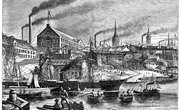By the late 1800s, Americans had developed a greater understanding of health issues and were becoming increasingly aware of the dangers associated with the spread of contagious diseases. Sanitary conditions in rural areas, such as farming communities, were generally acceptable and households often quarantined those who were sick. Living conditions and working conditions in large industrial cities were typically dirty, overpopulated and unsanitary, forcing residents to battle life-threatening diseases.
Disease Carried Overseas
Travel conditions aboard immigrant ships were germ-infested and unsanitary. Immigrants lived in tight quarters during their travel to America, and contagious diseases, such as scarlet fever, measles, small pox, diphtheria, typhoid fever and tuberculosis were quickly transmitted from one passenger to another. Children were especially susceptible to the diseases. Insufficient nutrition, spoiled food, a lack of sunlight, poor ventilation and unsanitary waste removal contributed to the poor conditions. As a result, America was inundated with disease-inflicted immigrants. The National Quarantine Act was established in 1878, giving the federal government control over quarantine measures. In 1891, federal immigration legislation made the Marine Hospital Service responsible for performing medical examinations on all newly arriving immigrants.
Tenement Housing
Factory workers in large industrial cities were often forced to live in tenement housing. Wages were low so workers couldn’t afford houses, hotels or upscale apartments, and resided in cheap, overpopulated, dirty, unsanitary lodging houses. Tenants often paid by the day, thus the term seven-cent lodging house earned its name. Crammed dwellers bunked side by side on canvas strips hung from the walls, similar to small hammocks. Septic tanks for sewage treatment weren’t available until 1895, so tenement houses didn’t have proper waste disposal methods. Fresh air, sunlight and proper nutrition were concerns in tenement houses.
Meat-Packaging Factories
Until the U.S. Meat Inspection Act was authorized by the Secretary of Agriculture in 1906, meat-slaughtering and meat-packaging factories were storehouses for germs and disease. Meat wasn’t properly refrigerated, inspected or tested, and consumers often got sick or died as a result of the bacteria-infested food. Conditions within the factories were also unsanitary and non-edible byproducts weren’t disposed of properly. The novel “The Jungle” by Upton Sinclair graphically describes the horribly unsanitary conditions that existed in the meat packing industry in the late 1800s and early 1900s.
Public Health Improvements
In the late 1800s, medical professionals, private doctors and public health agencies began to address the impact sanitation played on disease control. In rural and suburban areas, sanatoriums were built to house sick patients who suffered from diseases, such as tuberculosis. Sanatoriums had open porches to provide fresh air and easy access to the outdoors. Medical facilitators in urban areas opened free dispensaries and clinics where sick patients could receive medicine, medical advice and treatment. Even though unsanitary conditions and disease were problematic in the late 1800s, advancements helped extend the average life span and reduce deaths from common diseases, such as pneumonia and influenza.
Related Articles
References
Writer Bio
As curriculum developer and educator, Kristine Tucker has enjoyed the plethora of English assignments she's read (and graded!) over the years. Her experiences as vice-president of an energy consulting firm have given her the opportunity to explore business writing and HR. Tucker has a BA and holds Ohio teaching credentials.











